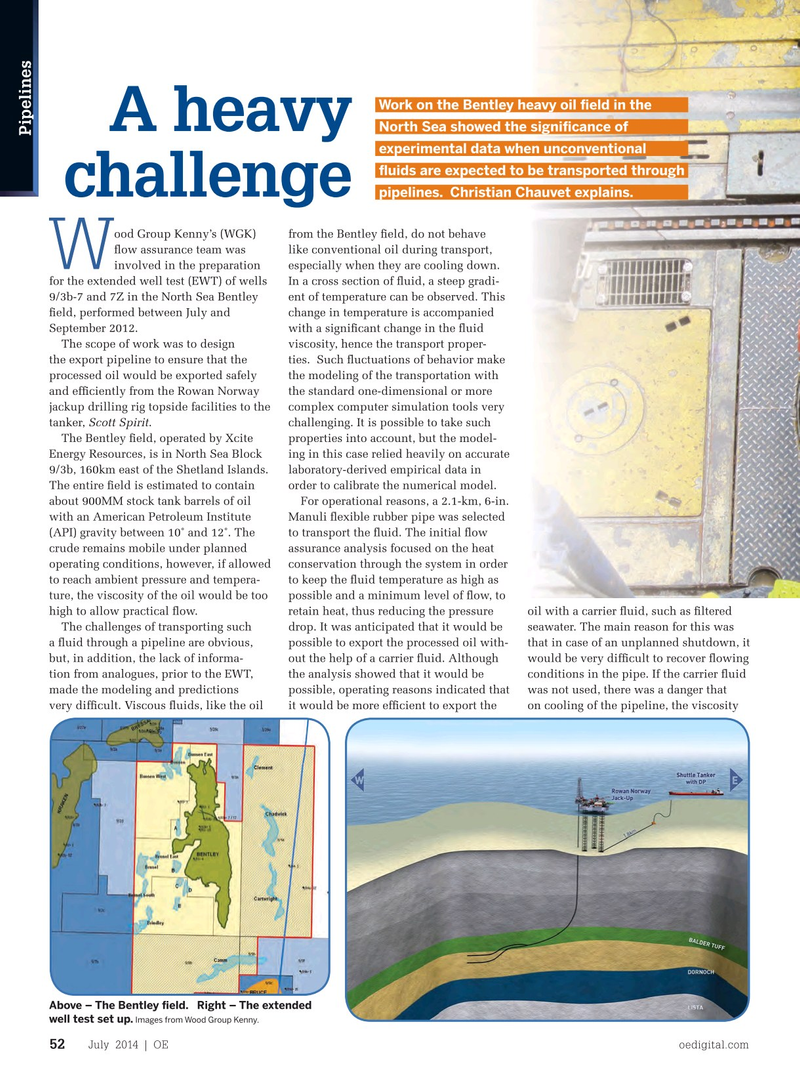
Page 50: of Offshore Engineer Magazine (Jul/Aug 2014)
Read this page in Pdf, Flash or Html5 edition of Jul/Aug 2014 Offshore Engineer Magazine
Work on the Bentley heavy oil ? eld in the
A heavy North Sea showed the signi? cance of
Pipelines experimental data when unconventional ? uids are expected to be transported through challenge pipelines. Christian Chauvet explains. ood Group Kenny’s (WGK) from the Bentley ? eld, do not behave ? ow assurance team was like conventional oil during transport,
W involved in the preparation especially when they are cooling down. for the extended well test (EWT) of wells In a cross section of ? uid, a steep gradi- 9/3b-7 and 7Z in the North Sea Bentley ent of temperature can be observed. This ? eld, performed between July and change in temperature is accompanied
September 2012. with a signi? cant change in the ? uid
The scope of work was to design viscosity, hence the transport proper- the export pipeline to ensure that the ties. Such ? uctuations of behavior make processed oil would be exported safely the modeling of the transportation with and ef? ciently from the Rowan Norway the standard one-dimensional or more jackup drilling rig topside facilities to the complex computer simulation tools very tanker, Scott Spirit. challenging. It is possible to take such
The Bentley ? eld, operated by Xcite properties into account, but the model-
Energy Resources, is in North Sea Block ing in this case relied heavily on accurate 9/3b, 160km east of the Shetland Islands. laboratory-derived empirical data in
The entire ? eld is estimated to contain order to calibrate the numerical model. about 900MM stock tank barrels of oil For operational reasons, a 2.1-km, 6-in. with an American Petroleum Institute Manuli ? exible rubber pipe was selected (API) gravity between 10° and 12°. The to transport the ? uid. The initial ? ow crude remains mobile under planned assurance analysis focused on the heat operating conditions, however, if allowed conservation through the system in order to reach ambient pressure and tempera- to keep the ? uid temperature as high as ture, the viscosity of the oil would be too possible and a minimum level of ? ow, to high to allow practical ? ow. retain heat, thus reducing the pressure oil with a carrier ? uid, such as ? ltered
The challenges of transporting such drop. It was anticipated that it would be seawater. The main reason for this was a ? uid through a pipeline are obvious, possible to export the processed oil with- that in case of an unplanned shutdown, it but, in addition, the lack of informa- out the help of a carrier ? uid. Although would be very dif? cult to recover ? owing tion from analogues, prior to the EWT, the analysis showed that it would be conditions in the pipe. If the carrier ? uid made the modeling and predictions possible, operating reasons indicated that was not used, there was a danger that very dif? cult. Viscous ? uids, like the oil it would be more ef? cient to export the on cooling of the pipeline, the viscosity
Above – The Bentley ? eld. Right – The extended well test set up. Images from Wood Group Kenny.
July 2014 | OE oedigital.com 52 052_OE0714_Pipelines2_Bentley.indd 52 6/20/14 7:04 PM

 49
49

 51
51